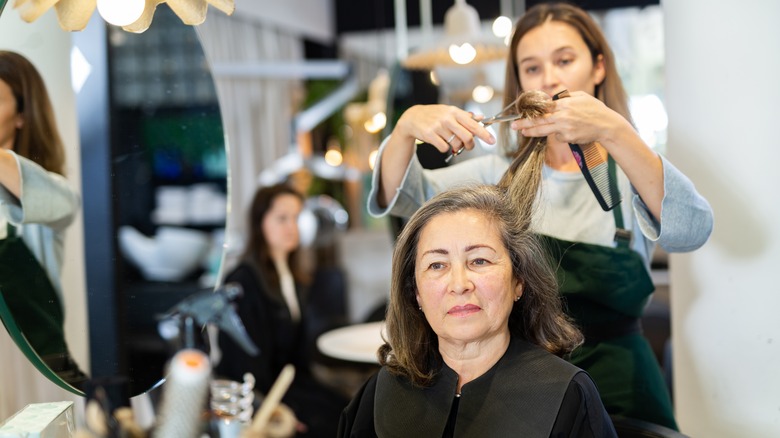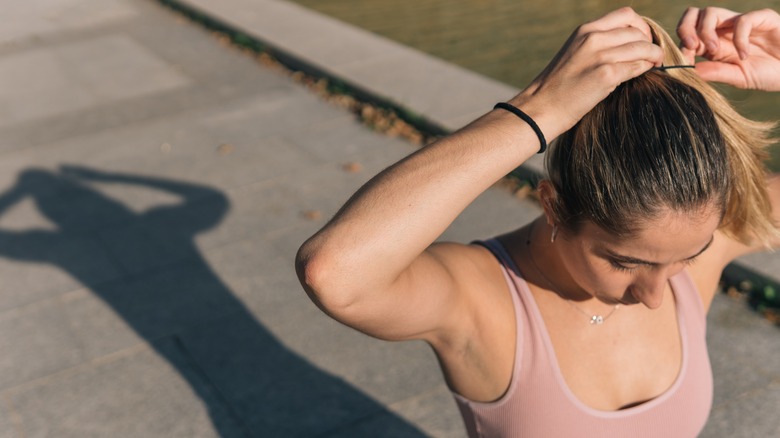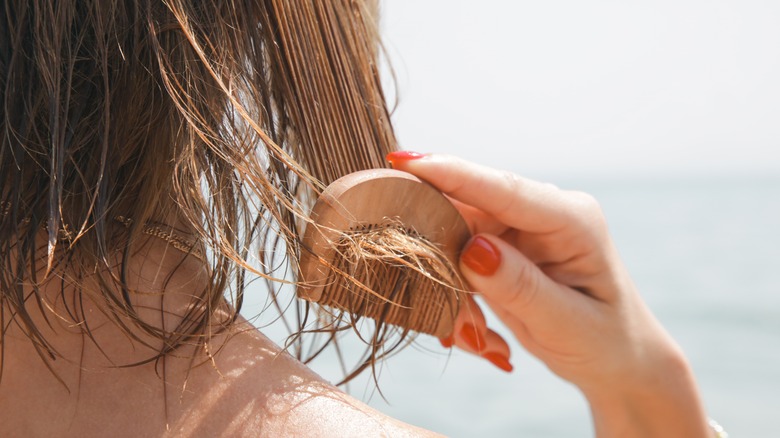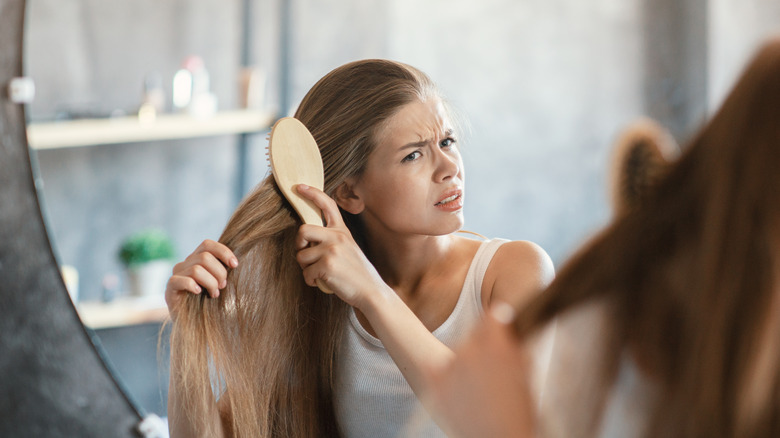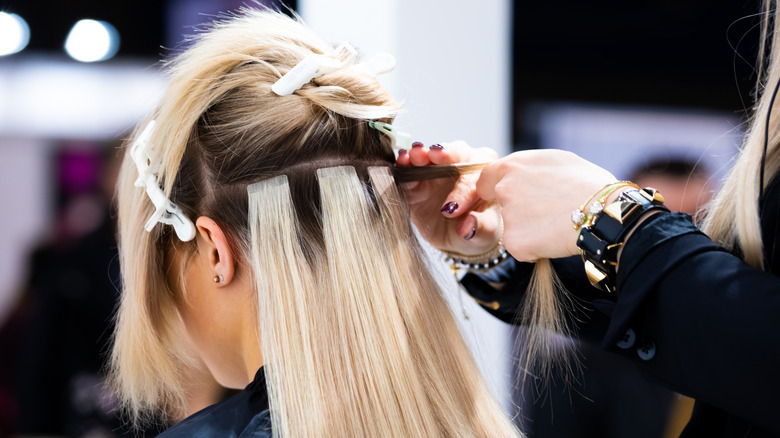5 Hairstyles That May Be Causing Damage To Your Follicles
Taking care of your hair can be quite an involved commitment, especially when considering which products, hairstyling tools, or hairstyles are best for your hair type. If you have started noticing some damage to your hair, such as breakage, thinning, or weakness, you might be wondering where it could be coming from. Because of all that goes into a haircare routine, it can feel difficult to pinpoint, but it might not be as complicated as you think.
In fact, it may have a lot to do with certain hairstyles you wear often. It's possible that they can be causing damage to your hair down to its follicle. Discovering which kind of hairstyles could be responsible for this damage can serve as a guide to knowing which ones to avoid completely and which ones to only wear on occasion, in order to maintain your hair's health. When you do choose to wear certain damaging styles, proceeding with caution and allowing your hair to recover when necessary will minimize any possible ill effects (via Real Simple).
Tight ponytails
First up is the high, tight ponytail. This is a popular hairstyle because it offers a quick and easy solution on the days when you're in a rush, dealing with greasy hair, or need to contain frizz. However, it can cause damage without you even knowing. Because it is tight, it pulls on your strands which can lead to breakage. And when hair breaks, it's damaged all the way down to its roots.
This style also has the potential to cause a receding hairline over time, especially with follicle damage. "Tight ponytails or tight braids, anything that pulls on the scalp and causes headache is a big culprit," celebrity hair and makeup artist Vibha Gusain told Vogue. Pulling your hair in a bun can cause similar damage.
Additionally, elastic hair ties themselves can also cause hair strands to break. To help protect your locks, consider alternatives like soft scrunchies or trendy 90s-style claw clips.
Wet hairstyles
Your hair is fragile when wet. Putting your hair up immediately after a shower might not be the best idea, even if it's convenient. Updos, braids, twists, or any other style that pulls on your wet hair can cause some serious damage. According to Head & Shoulders, hair is made of keratin, a type of protein, that is protected by the outer layer of the hair shaft known as the cuticle. These proteins form weaker bonds when the hair is wet versus when it is dry, making it more susceptible to damage. Combing, brushing, or putting your hair up stretches the hair and can cause the cuticle to deform. When it deforms, it exposes the sensitive proteins it should be protecting.
"If you have any weak points on your hair strands — which chances are, you definitely do! — then those spots are going to be even weaker when wet," hairstylist Jenna Marie Shafer told Byrdie. "So, twisting, pulling, or stretching your wet hair into an updo is just asking for it to snap off." When you put together the pulling, certain accessories, such as the elastic band or bobby pins, and the vulnerability of the wet hair, you are at risk of getting split ends, breakage, thinning, and even hair loss. If you like the wet hair look, wait for it to dry and fake it with a shine spray.
Hairstyles that require heat
Hairstyles that require the use of heat-styling tools can negatively impact the health of your hair. Unless you naturally have straight hair, you're probably using a flat iron to achieve a slick look, or you're using a curling iron to create voluminous curls. This can cause damage, such as roughness, dryness, and frizz.
Much like when hair is wet, the thermal heat touching your hair causes the cuticle to open up. "Using multiple passes of thermal heat is physically changing the inner molecular structure of the hair," celebrity hairstylist and colorist Bianca Hillier told Byrdie. "It opens the most outer cuticle layer and enters inside to break the bonds of the hair (or the skeleton of the hair). This is how split ends are formed." According to Dyson, when using tools over 300 degrees Fahrenheit, alpha-keratin bonds become beta-keratin bonds which cause the hair to weaken and lose its elasticity. This then makes it prone to even further damage.
Ideally, you should avoid using heat-styling tools every day. And when you do use them, make sure to protect your hair from the heat as much as you can by using heat-protectant sprays.
Teased hairstyles
Teasing is great for volumizing your hair when you're short on time, but the convenience isn't without consequences. In order to create its alluring lift, teasing your strands adds the friction they need to rebel against their normal, flat position. Because teased hair is lifted off of the follicles, you may think that this would keep them safe from damage. On the contrary, aggravating your hair in this way can lead to increased breakage and split ends. Your hair is coated in cuticle cells, which all naturally point downward. As you tease, you reverse this direction — damaging the flow or stripping the strand altogether. Volumizing hair products are a gentler alternative to teasing.
If you're not ready to completely relinquish this '80s style, there are some ways you can minimize damage. First, ensure that your hair is fully dry before beginning teasing. Not only will this stop heavier, wet hair from falling out of its teased position, but you're also working with your hair when it is at its strongest. It may also be worthwhile to invest in a teasing comb. Specific products exist to create this effect, which can be more efficient and gentle than making do with your typical hairbrush.
Hairstyles with long extensions
If you have especially long hair, you might worry about the increased strain on your follicles. Fortunately, this typically isn't an issue, unless you have an established problem with excess hair loss. Your head should be able to support Rapunzel-level styles, and any impression you may have of increased hair loss is probably a result of having more hair to notice as it sheds.
Long hair extensions, on the other hand, can cause damage. While you may think that reinforcing your natural growth with artificial backup would add an additional layer of protection, the installation process can strain your strands. The American Academy of Dermatology explains that some forms of extensions or weaves require your natural hair to be tightly pulled back against the scalp. With your hair resting in this tense position for the duration of your hairstyle, strands can experience breakage or even fall out. If your follicles are already damaged, this hair loss could even be permanent.
